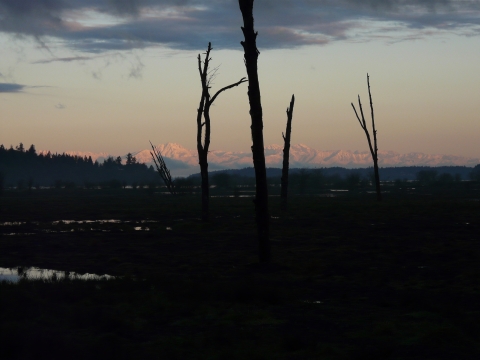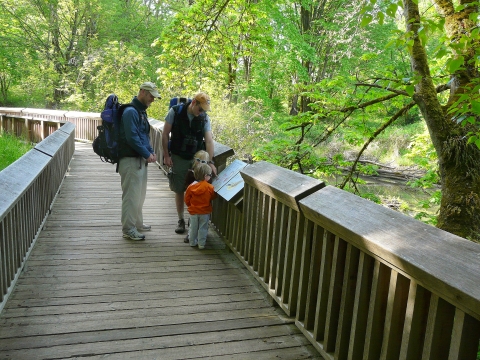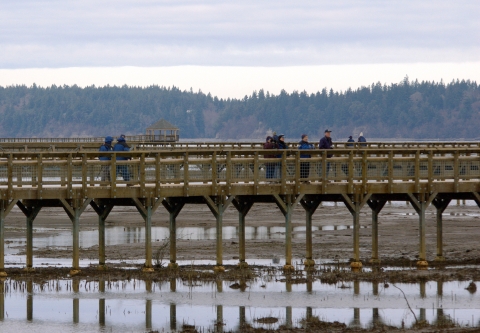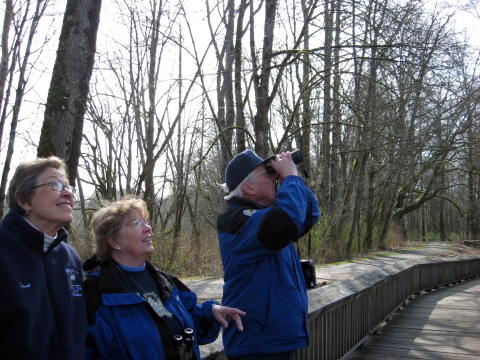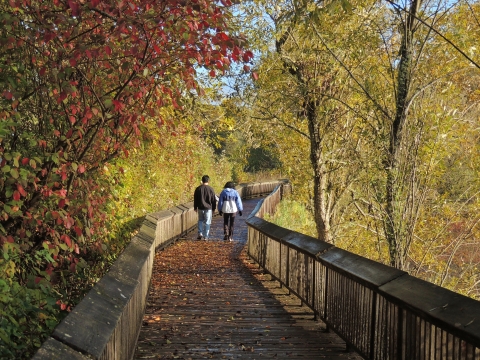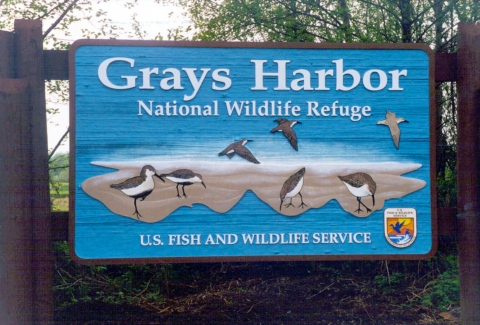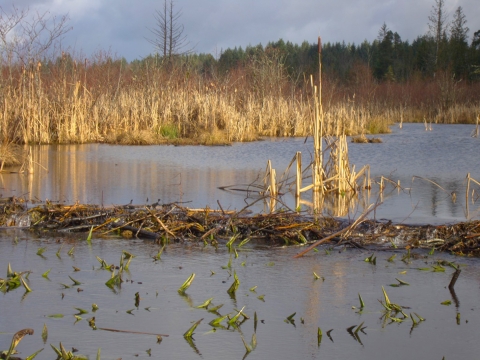Visit Us
The grounds are open every day sunrise to sunset, the office 9-4 Monday-Friday, and the visitor center 9-4 Wednesday-Sunday. National wildlife refuges offer us a chance to unwind from the stresses of daily life and reconnect with our natural surroundings. We are located just off Interstate 5 in Olympia, Washington, where you can immerse yourself in the diverse habitats of the Nisqually River Delta, hear the cacophony of bird songs, and observe wildlife in their natural environment. Year-round trails offer different wildlife viewing opportunities with each season and tidal stage. To make the most of your visit, start at the Norm Dicks Visitor Center where refuge volunteers will help you plan your time and provide recent wildlife sightings. Exhibits in the center offer a good overview of the Nisqually River watershed, the wildlife, and the habitats found here.
Limited on time?
If you have 15-minutes...
Visit the Norm Dicks Visitor Center (open 9-4 Wed.-Sun.) and discover where the Nisqually River begins and how the Nisqually River Delta is formed (hint: this is the only watershed that begins in a national park and ends in a national wildlife refuge national wildlife refuge
A national wildlife refuge is typically a contiguous area of land and water managed by the U.S. Fish and Wildlife Service for the conservation and, where appropriate, restoration of fish, wildlife and plant resources and their habitats for the benefit of present and future generations of Americans.
Learn more about national wildlife refuge ). Volunteers are available to answer questions and reveal recent wildlife sightings on the refuge. A viewing platform outside the visitor center looks out over the permanent wetland and provides a glimpse of wildlife. The Nature Shop provides a range of books and gifts; purchases benefit the Friends of Nisqually National Wildlife Refuge Complex and support education and recreation at our site.
If you have one hour...
After the visitor center, take a walk on the Twin Barns Loop Trail that begins from each parking area. This trail provides visitors a good view of the permanent wetland, Nisqually River, and riparian riparian
Definition of riparian habitat or riparian areas.
Learn more about riparian habitats, and the wildlife they support. This loop is a mile long and level, mostly on boardwalk.
If you have 3 or more hours...
In addition to the visitor center, visitors can reach the end of the Nisqually Estuary Boardwalk that extends over the estuary. If it's a clear day, Mount Rainier and the Olympic Mountain range is visible and depending on the season and tide, sea ducks and seals may be observed along the route. This 4-mile round-trip walk takes visitors through all the refuge habitats, from permanent wetlands to the estuary and along the Nisqually River.
The tide can greatly affect what you see at our refuge. Here are some tips:
- Tides of 10 feet or less: Lots of mud is exposed. This is good for herons, shorebirds, and dabbling ducks.
- Tides 10-11 feet high: Tides cover most of the mudflats around the Estuary Boardwalk. This is good for dabbling ducks.
- Tides 11-13 feet high: Some woody debris can still be spotted on the mudflat, but the water is deeper. This is good for diving ducks and seabirds.
- Tides over 13 feet: Lots of water is around the Estuary Boardwalk. This is good for diving birds.
Find out what tidal conditions to expect during your visit at tides.net.
Entrance Fees
The daily entrance fee is $3.00 per four adults and children under 16 years are admitted free. We can only accept cash or checks, not credit cards.
Fees can be paid at the entrance fee kiosk located near the entry to the Norm Dicks Visitor Center. Please use the blue envelopes to insert cash or check into the metal canister. We advise visitors to keep the tear-off receipt and/or pass with you while on the trails.
We accept and sell the America the Beautiful passes that provide free entrance to the refuge and all other federal lands. All of these passes will admit the pass holder and 3 additional adults. Children under 16 enter free. These include:
- America the Beautiful Annual Pass: $80.00
- Lifetime Senior Pass (formerly Golden Age): $80.00 for 62 years or older
- Annual Senior Pass: $20.00
- Access Pass: free lifetime pass for people with disabilities; applicants must sign a statement affirming permanent disability
- Annual Military Pass: free pass for active duty personnel, reservists, and National Guard military personnel as well as their dependents
- Lifetime Veterans Pass: free pass for veterans (non-active duty personnel). Does not apply to dependents.
- Gold Star Families with vouchers: free
We also accept and sell:
- Annual Federal Duck Stamp: $25.00 (free admission to National Wildlife Refuges from July 1 to June 30)
- Annual Refuge Pass (only for Billy Frank Jr. Nisqually NWR): $12.00
These passes are available at the administration office and visitor center. A majority of the proceeds from entrance fees and passes is returned to the refuge for visitor programs.
Keep in mind we are a federal facility, and the Washington State Discover Pass is not accepted for entrance to national wildlife refuges.
Restrooms
Restrooms are available across from the Norm Dicks Visitor Center. Portables are located next to the Twin Barns.
Activities
Billy Frank Jr. Nisqually National Wildlife Refuge is a perfect destination to be immersed into nature and leave the hustle and bustle of urban life behind. Once on the trails, visitors will be immersed into the different habitats representing the Nisqually River Delta. The refuge provides opportunities to explore the natural and cultural history of the southern Puget Sound region through exhibits in the Norm Dicks Visitor Center or from interpretive panels along the trails. Walk along the Nisqually Estuary Boardwalk and observe harbor seals resting on salt marsh salt marsh
Salt marshes are found in tidal areas near the coast, where freshwater mixes with saltwater.
Learn more about salt marsh islands, walk the Riparian Forest trail and look for salmon in the slough, or walk the infamous Nisqually Estuary Boardwalk that extends one mile over the Nisqually estuary. Seasonal guided walks and lectures are offered, and the environmental education program provides students with hands-on learning experiences in nature. Each season reveals different vistas and viewing opportunities.
Trails
Four miles of trails offer access to a diversity of habitats within Billy Frank Jr. Nisqually National Wildlife Refuge with views of native plants and wildlife, from amphibians to mammals. The trails are relatively flat and accessible wooden boardwalks and gravel paths. Interpretive panels give a glimpse of what can be seen, or heard, along the route. Average time spent on the trails is approximately two hours but is dependent on wildlife activity and individual preference. Benches are placed on all trails except the gravel Nisqually Estuary Trail. Depending on the season and weather forecast, be prepared with raingear and water. Restrooms are located adjacent to the Norm Dicks Visitor Center, and portable toilets are placed at the Twin Barns.
Other Facilities in the Complex
Nisqually National Wildlife Refuge Complex is comprised of three refuges in western Washington.
Grays Harbor National Wildlife Refuge
Located in Hoquiam, Washington, approximately 56 miles west of Olympia, the refuge is known for large concentrations of migratory shorebirds, especially in spring months as they travel north to breeding grounds. The Grays Harbor estuary was designated a hemispheric reserve by the Western Hemisphere Shorebird Reserve network and is one of six major stopover areas between Alaska and South America. The Sandpiper Trail is open year-round and offers closer views to witness hundreds of thousands of shorebirds foraging, resting, and evading aerial predators.
Black River Unit of Nisqually National Wildlife Refuge Complex
Located southwest of Olympia, the unit was established to protect the Black River watershed for biological diversity. We enhance and manage unique wetland and riparian riparian
Definition of riparian habitat or riparian areas.
Learn more about riparian ecosystems for the benefit of anadromous salmonid production and rearing, for migratory and resident birds, and for other wetland-dependent wildlife. Read the Comprehensive Conservation Plan for more information.
Rules and Policies
The refuge offers wildlife-dependent recreation for visitors and rules are in place to protect wildlife and the habitat they rely upon. Wildlife on the refuge need to feed and rest with minimal disturbance by humans and this can result in better viewing opportunities for visitors. Please be mindful of allowing wildlife to remain undisturbed and be respectful of other visitors. Activities at a national wildlife refuge national wildlife refuge
A national wildlife refuge is typically a contiguous area of land and water managed by the U.S. Fish and Wildlife Service for the conservation and, where appropriate, restoration of fish, wildlife and plant resources and their habitats for the benefit of present and future generations of Americans.
Learn more about national wildlife refuge are restricted unless specifically allowed. If it's not a wildlife-dependent activity (birdwatching, wildlife viewing, wildlife photography), then it's probably restricted or not allowed. This list of the refuge's rules and policies is not comprehensive. Before you act, ask first!
Locations



















Billy Frank Jr. Nisqually National Wildlife Refuge is located on the Interstate 5 corridor, 20 miles south of Tacoma and 8 miles east of Olympia in the Nisqually Valley. The area is not easily missed when driving on the highway - the vista opens up and the estuary leading to South Puget Sound is visible on the north side of the interstate.
Billy Frank Jr. Nisqually National Wildlife Refuge is located 8 miles northeast of Olympia, Washington, at 100 Brown Farm Road, Olympia, WA 98516:
- Southbound on Interstate 5: take exit 114. Turn right at the traffic light, go under I-5, and make a right turn into the Refuge. Follow the entrance road to the two public parking lots.
- Northbound on Interstate 5: take exit 114. Turn left at the stop sign, go under I-5, and make a right turn into the Refuge. Follow the entrance road to the two public parking lots.
